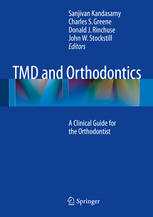TMD و ارتودنسی: راهنمای بالینی برای متخصص ارتودنسی ۲۰۱۵
TMD and Orthodontics: A clinical guide for the orthodontist 2015
دانلود کتاب TMD و ارتودنسی: راهنمای بالینی برای متخصص ارتودنسی ۲۰۱۵ (TMD and Orthodontics: A clinical guide for the orthodontist 2015) با لینک مستقیم و فرمت pdf (پی دی اف)
| نویسنده |
Charles S. Greene, Donald J. Rinchuse, John W. Stockstill, Sanjivan Kandasamy |
|---|
| تعداد صفحهها |
148 |
|---|---|
| نوع فایل |
|
| حجم |
6 Mb |
| سال انتشار |
2015 |
89,000 تومان
معرفی کتاب TMD و ارتودنسی: راهنمای بالینی برای متخصص ارتودنسی ۲۰۱۵
این کتاب مبتنی بر شواهد با کمک متخصصان مشهور جهان به تفصیل آناتومی عملکردی مفصل گیجگاهی فکی و همچنین علت شناسی، تشخیص، درمان و پیامدهای پزشکی-حقوقی برای بیماران مبتلا به اختلالات گیجگاهی فکی (TMD) را مورد بحث قرار می دهد. در درک ما از علت شناسی اختلالات TMJ و در توسعه منطق درمان فعلی، تعدادی از مسائل بحث برانگیز هستند. اینها شامل میزانی است که مفصل گیجگاهی فکی باید کانون اصلی تشخیص و درمان ارتودنسی باشد و همچنین نقشی که اکلوژن و مال اکلوژن در تسریع علائم اختلالات TMJ ایفا می کنند. در واقع، موضوعات کمی در دندانپزشکی و تخصص ارتودنسی وجود دارد که به اندازه TMD قابل تفسیر یا تفسیر نادرست باشد. این کتاب درسی اطلاعات و راهنمایی های ضروری را به متخصصان ارتودنسی ارائه می دهد که به آنها کمک می کند تا این مشکل پیچیده و چند لایه را درک کنند و به طور مؤثر مدیریت کنند. در کل، دستورالعمل های بالینی واضحی بر اساس شواهد علمی و بالینی فعلی ارائه شده است. TMD و ارتودنسی منبع ارزشمندی برای ارتودنتیست ها در کنار صندلی در همه جا خواهد بود.
This evidence-based book, featuring contributions from world-renowned experts, discusses in detail the functional anatomy of the temporomandibular joint as well as the aetiology, diagnosis, treatment and medicolegal implications of patients with temporomandibular disorders (TMD).Despite advances in our understanding of the aetiology of TMD and in developing current treatment rationales, a number of issues remain controversial. These include the extent to which the temporomandibular joint should be a central focus of orthodontic diagnosis and treatment, as well as the role that occlusion and malocclusion play in precipitating TMD symptoms. Indeed, few subjects in dentistry and the specialty of orthodontics are open to as many interpretations or misinterpretations as TMD. This textbook provides clinical orthodontists with essential information and guidance that will assist them in understanding and effectively managing this complex multilayered problem. Throughout, clear clinical guidelines are presented on the basis of current scientific and clinical evidence. TMD and Orthodontics will be a highly valuable chairside resource for orthodontists everywhere.



